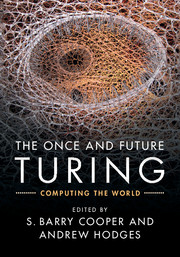Book contents
- Frontmatter
- Contents
- Contributors
- Preface
- Introduction
- Part One Inside Our Computable World, and the Mathematics of Universality
- Part Two The Computation of Processes, and Not Computing the Brain
- 6 What Alan Turing Might Have Discovered
- 7 Designed versus Intrinsic Computation
- 8 Dull Rigid Human meets Ace Mechanical Translator
- Part Three The Reverse Engineering Road to Computing Life
- Part Four Biology, Mind, and the Outer Reaches of Quantum Computation
- Part Five Oracles, Infinitary Computation, and the Physics of the Mind
- Afterword
- References
7 - Designed versus Intrinsic Computation
from Part Two - The Computation of Processes, and Not Computing the Brain
Published online by Cambridge University Press: 05 March 2016
- Frontmatter
- Contents
- Contributors
- Preface
- Introduction
- Part One Inside Our Computable World, and the Mathematics of Universality
- Part Two The Computation of Processes, and Not Computing the Brain
- 6 What Alan Turing Might Have Discovered
- 7 Designed versus Intrinsic Computation
- 8 Dull Rigid Human meets Ace Mechanical Translator
- Part Three The Reverse Engineering Road to Computing Life
- Part Four Biology, Mind, and the Outer Reaches of Quantum Computation
- Part Five Oracles, Infinitary Computation, and the Physics of the Mind
- Afterword
- References
Summary
Top-down versus bottom-up design
The design of modern products commonly follows a well-defined path, such as for example the human-centered approach used by the famous IDEO design consultancy, Kelley (2001). Design has turned into a process that can be studied, formalized, learned, and improved. As Tom Kelley (2001) explains, IDEO uses a methodology that has the following five basic steps: understand, observe, visualize, evaluate and refine, implement. Two things are important to notice in this process. First, there is an implicit “loop” for the evaluation and refinement process. No product is perfect from the beginning and most of them will need to be refined and re-evaluated over and over again. Second, the process is organized in a very top-down manner, i.e., it is a step-wise process that starts with a high-level goal, target, or vision and then gradually follows down in the hierarchy by specifying, evaluating, and implementing the lower-level (sub)systems. That is the way engineers design cars, airplanes, computers, and whatnot. The most important reason why top-down design has been so successful in the engineering world is divide et impera, or in more contemporary words, divide and conquer. Top-down design allows us to handle complex problems and to treat subsystems as abstract black boxes. While this generally works well in the engineering world, an entirely different design process can be observed in nature. Nature proceeds in a bottom-up way by simple trial and error. The process is called evolution and has led to amazing, albeit by no means perfect, ‘designs. ’ As the name says, bottom-up design proceeds from the bottom up by piecing subsystems into something bigger. Often, the functionality of the resulting system is greater than the sum of its parts. In that context, the term emergence (Holland, 1999) comes up frequently. Loosely speaking, emergence means that the interactions of the subsystem components do not necessarily allow us to predict the behavior at the next level. There is an element of surprise (Ronald et al., 1999) involved, which describes that non-predictibility nicely.
Today, the computing disciplines face difficult challenges from extending CMOS technology to and beyond dimensional scaling. One solution path is to use an innovative combination of novel manufacturing techniques, devices, compute paradigms, and architectures to create new information processing technology that may be radically different from what we currently know.
- Type
- Chapter
- Information
- The Once and Future TuringComputing the World, pp. 106 - 116Publisher: Cambridge University PressPrint publication year: 2016

